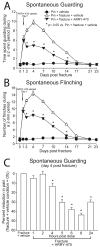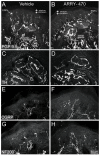Sustained blockade of neurotrophin receptors TrkA, TrkB and TrkC reduces non-malignant skeletal pain but not the maintenance of sensory and sympathetic nerve fibers
- PMID: 20854944
- PMCID: PMC3020250
- DOI: 10.1016/j.bone.2010.09.019
Sustained blockade of neurotrophin receptors TrkA, TrkB and TrkC reduces non-malignant skeletal pain but not the maintenance of sensory and sympathetic nerve fibers
Abstract
Current therapies for treating skeletal pain have significant limitations as available drugs (non-steroidal anti-inflammatory drugs and opiates) have significant unwanted side effects. Targeting nerve growth factor (NGF) or its cognate receptor tropomysin receptor kinase A (TrkA) has recently become an attractive target for inhibition of adult skeletal pain. Here we explore whether sustained administration of a selective small molecule Trk inhibitor that blocks TrkA, TrkB and TrkC kinase activity with nanomolar affinity reduces skeletal pain while allowing the maintenance of sensory and sympathetic neurons in the adult mouse. Twice-daily administration of a Trk inhibitor was begun 1 day post fracture and within 8 h of acute administration fracture pain-related behaviors were reduced by 50% without significant sedation, weight gain or inhibition of fracture healing. Following administration of the Trk inhibitor for 7 weeks, there was no significant decline in the density of unmyelinated or myelinated sensory nerve fibers, sympathetic nerve fibers, measures of acute thermal pain, acute mechanical pain, or general neuromuscular function. The present results suggest that sustained administration of a peripherally selective TrkA, B and C inhibitor significantly reduces skeletal pain without having any obvious detrimental effects on adult sensory and sympathetic nerve fibers or early fracture healing. As with any potential therapeutic advance, understanding whether the benefits of Trk blockade are associated with any risks or unexpected effects will be required to fully appreciate the patient populations that may benefit from this therapeutic approach.
Published by Elsevier Inc.
Figures






References
-
- Brooks PM. The burden of musculoskeletal disease-a global perspective. Clin Rheumatol. 2006;25:778–81. - PubMed
-
- Woolf AD, Pfleger B. Burden of osteoporosis and fractures in developing countries. Curr Osteoporos Rep. 2005;3:84–91. - PubMed
-
- Xian CJ, Zhou XF. Treating skeletal pain: limitations of conventional anti-inflammatory drugs, and anti-neurotrophic factor as a possible alternative. Nat Clin Pract Rheumatol. 2009;5:92–8. - PubMed
-
- Balano KB. Anti-inflammatory drugs and myorelaxants. Pharmacology and clinical use in musculoskeletal disease. Prim Care. 1996;23:329–34. - PubMed
-
- Simon AM, Manigrasso MB, O'Connor JP. Cyclo-oxygenase 2 function is essential for bone fracture healing. J Bone Miner Res. 2002;17:963–76. - PubMed
Publication types
MeSH terms
Substances
Grants and funding
LinkOut - more resources
Full Text Sources
Other Literature Sources
Medical
Research Materials

